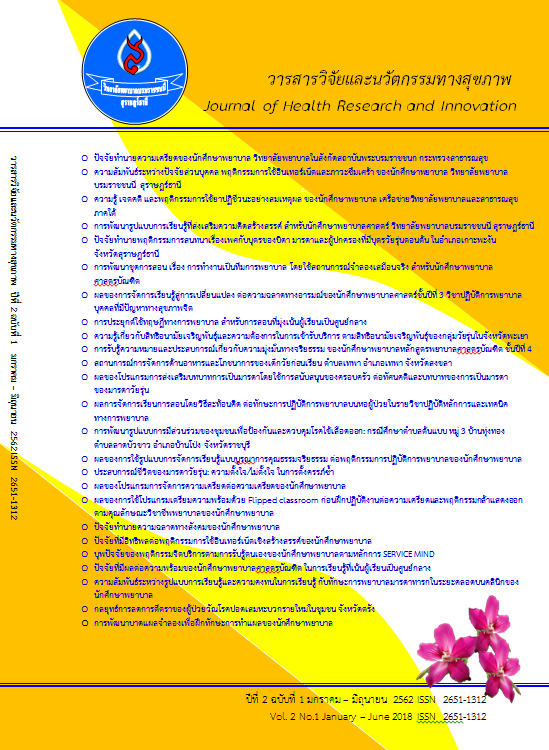ปัจจัยทำนายความฉลาดทางสังคมของนักศึกษาพยาบาล
คำสำคัญ:
นักศึกษาพยาบาล, ความฉลาดทางสังคม, ปัจจัยทำนายบทคัดย่อ
การวิจัยครั้งนี้เป็นการศึกษาความสัมพันธ์เชิงทำนาย มีวัตถุประสงค์ เพื่อศึกษาความฉลาดทางสังคมและปัจจัยทำนายความฉลาดทางสังคมของนักศึกษาพยาบาล กลุ่มตัวอย่างเป็นนักศึกษาพยาบาลศาสตร์ ชั้นปีที่ 1-4 ปีการศึกษา 2561 ในวิทยาลัยพยาบาลบรมราชชนนี จังหวัดนนทบุรี จำนวน 92 คน ได้มาจากการคำนวณกลุ่มตัวอย่างด้วยโปรแกรม G*POWER โดยใช้วิธีการสุ่มอย่างง่าย ด้วยวิธีการจับฉลากแบบไม่ใส่คืน ทีละคน เครื่องมือที่ใช้ในการเก็บรวบรวมข้อมูลได้แก่ แบบวัดความฉลาดทางสังคม ซึ่งมี 5 ด้าน ประกอบด้วย การตระหนักรู้สถานการณ์ ความร่วมรู้สึกอย่างแท้จริง การแสดงตน การนำเสนอตนเอง และ การเอื้ออำนวยในสังคม มีค่าความเที่ยงเท่ากับ .82 วิเคราะห์ข้อมูลโดยใช้สถิติพรรณนา และสถิติถดถอยพหุคูณ
ผลการวิจัย พบว่า กลุ่มตัวอย่างมีค่าเฉลี่ยของคะแนนความฉลาดทางสังคมอยู่ในระดับปานกลาง (Mean = 121.89, SD = 13.07) การตระหนักรู้สถานการณ์ และการเอื้ออำนวยในสังคมสามารถร่วมกันทำนายความฉลาดทางสังคมของนักศึกษาพยาบาลได้ร้อยละ 48.6 (R2 = .486, p < .01) ผลจากการศึกษาครั้งนี้ สามารถนำไปใช้พัฒนาแนวทางการส่งเสริมความฉลาดทางสังคมของนักศึกษาพยาบาล
เอกสารอ้างอิง
Gardner, H., & Hatch, T. (1989). Multiple intelligences go to school: Educational implications of the theory of multiple intelligences. Educational Researcher, 18(8), 4-9.
Lepkhao, D. (2006). The development of adolescent students’ social intelligence through Integrative group counseling model. Bangkok: Journal of The Royal Thai Army Nurses, 18(3), 62-71. (in Thai).
Kihlstrom, J. F., & Cantor, N. (2000). Social intelligence. In R. J. Sternberg (Ed.), Handbook of intelligence (pp. 359-379). New York, NY, US: Cambridge University Press.
Kosmitzki, C., & John, O. P. (1993). The implicit use of explicit conceptions of social intelligence. Personality and Individual Differences, 15(1), 11-23.
Gardner, H. (2011). Frames of mind: The theory of multiple intelligence (10th ed.). New York: Basic Book.
Goleman, D., & Boyatzis, R. (2008). Social intelligence and the biology of leadership. Harvard Business Review, 86(9), 74-81.
Srisahitnaragul, B. (2001). The methodology in nursing research. Bangkok. U & I intermedia. (in Thai).
Techarin, P. (2006). Social intelligence. Retrieved March, 30 2019 from http://www.nidambe11. net/ekonomiz/2006q4/ 2006dec05p6.htm (in Thai).
Thorndike, E. L. (1920). A constant error in psychological ratings. Journal of Applied Psychology, 4,(1), 25-29.
Trepatee, S. & Sungthong, P. (2009). Pediatrics journal of Nursing. 52(1), 36-43. Bangkok. Chulalongkorn University. (in Thai)
Pholanan, T. & Wisutikulpanih, J. (1998). Head First. Bangkok. Khwankao Press. (in Thai).
Songsiri, N., & Musikaphan, W. (2011). Cyber-bullying among secondary and vocational students in Bangkok. Journal of Population and Social Studies, 19(2), 235-242.
Suwitthayarat, K. (2014). The study and development of social intelligence for higher education students in the south of Thailand. Bangkok: Suthiparithat Journal, 28(86), 126-151.(in Thai).
Vasilova K., & Vyrost J. (2004). Solving Interpersonal Situation as The Indicator Of Social Intelligence. Studia Psychologica. 46,(4), 279-285.
Wallenius, M., Punamäki, R. L., & Rimpelä, A. (2007). Digital game playing and direct and indirect aggression in early adolescence: The roles of age, social intelligence, and parent-child communication. Journal of Youth and Adolescence, 36(3), 325-336.
ดาวน์โหลด
เผยแพร่แล้ว
รูปแบบการอ้างอิง
ฉบับ
ประเภทบทความ
สัญญาอนุญาต
บทความที่ได้รับการตีพิมพ์เป็นลิขสิทธิ์ของวารสารวิทยาลัยพยาบาลบรมราชชนนี สุราษฎร์ธานี
ข้อความที่ปรากฏในบทความแต่ละเรื่องในวารสารวิชาการนี้เป็นความคิดเห็นส่วนตัวของผู้เขียนแต่ละท่านไม่เกี่ยวข้องกับวิทยาลัยพยาบาลบรมราชชนนี สุราษฎร์ธานี และคณาจารย์ท่านอื่นๆในวิทยาลัยฯ แต่อย่างใด ความรับผิดชอบองค์ประกอบทั้งหมดของบทความแต่ละเรื่องเป็นของผู้เขียนแต่ละท่าน หากมีความผิดพลาดใดๆ ผู้เขียนแต่ละท่านจะรับผิดชอบบทความของตนเองแต่ผู้เดียว



